As winter’s chill gives way to the gentle warmth of spring, the world around us begins to awaken in a burst of vibrant greens and fragrant blooms. This season of renewal brought a full basket of fresh wild garlic that inspired our kitchen creations.
Wild garlic is a green treasure, an early spring gem favored by foragers, cooks and bears. Like the bears that feast on wild garlic after their long winter slumber, we adore its flavors and vibrant green color.
Let nature’s springtime spirit add its magic treasures to your table. Join us today to craft a perfect creamy wild garlic risotto.
Wild garlic – the green treasure of spring
Wild garlic (Allium ursinum), also called bear’s garlic, ramsons, or buckrams, is native to Europe and parts of Asia but can be found in other temperate regions worldwide.
It forms dense carpets of green leaves in damp, nutrient-rich soil near rivers and streams. Wild garlic also thrives in deciduous forests, particularly under beech trees, where the canopy provides the right amount of shade and the soil is rich and moist. It’s quite common to find it in late spring, growing in beech forests at higher altitudes.
Wild garlic is also cultivated and grown in many US gardens with sufficient shade and moisture.
The amazing plant is part of the Allium genus and is closely related to garlic (Allium sativum) and onions (Allium cepa). It has numerous health benefits, including antibacterial and anti-inflammatory properties, making it a treasure among foraged foods.

How to find wild garlic
In early spring, lush green carpets of wild garlic grow in damp, shady woodland areas, near riverbanks, or along hedgerows.
Its broad, spear-shaped leaves have a smooth, glossy surface. They grow from the base in a basal rosette pattern and can reach up to 25 cm (10 inches) in length. The leaves are vibrant green and emit a strong garlicky aroma when crushed.
Wild garlic is usually safe to forage, but sometimes, it can be mistaken for a few poisonous plants, posing serious health risks. The best way to identify it is to crush a leaf between your fingers – the smell of wild garlic is unmistakable. Also, it’s easier to be sure you’re picking the right plant when the small, white, star-shaped wild garlic flowers start to bloom,

Why you’ll love wild garlic risotto
- Wild garlic risotto combines the fresh, vibrant taste of wild garlic with the creaminess of the risotto, and it can be made in less than 3o minutes.
- Unlike our other season-inspired foraged foods, like wild garlic pizza, black trumpet risotto, bulgur risotto with chanterelles tagliatelle with porcini, porcini risotto and breaded saffron milk caps, wild garlic can be cooked all year round when stored as pesto or frozen.
- It looks good; the more wild garlic you add, the more you crush it, and the greener it gets. Have you seen the color of wild garlic pasta?
- And it’s so versatile; plenty of other vegetables or meat can be added to it, and you can pair it with numerous other dishes. How about adding wild garlic to porcini risotto? Or (this is so yummy) mixing in basil pesto with pistachios?
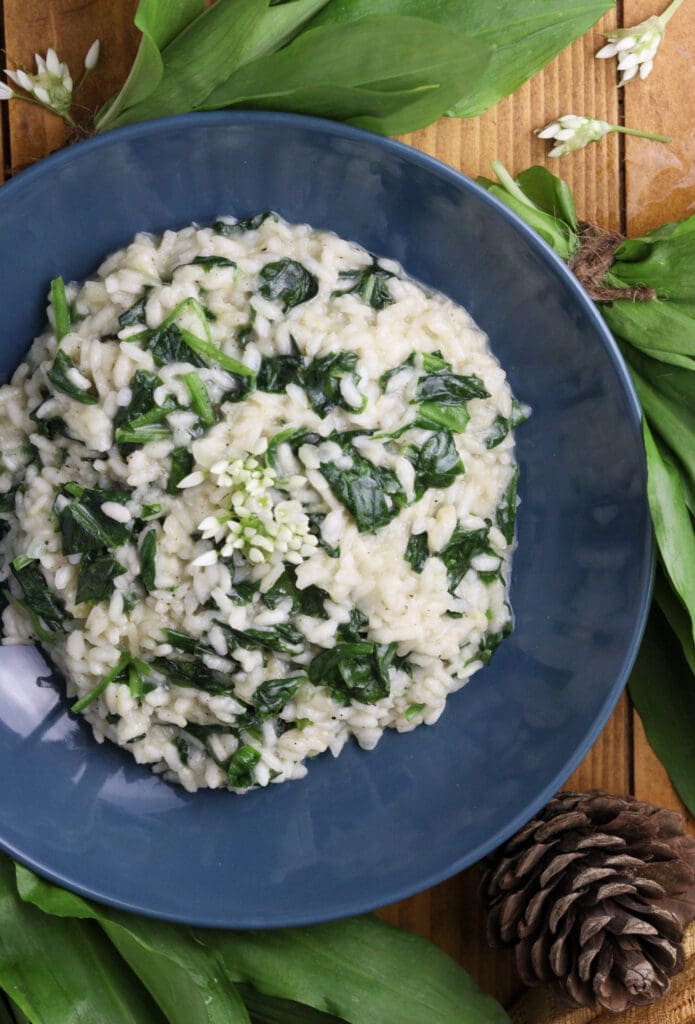
Ingredients you’ll need
WILD GARLIC LEAVES – Fresh wild garlic leaves were used in this recipe, although if you’re cooking wild garlic risotto in winter, you might also use frozen blanched wild garlic or wild garlic pesto. With pesto, it will get much greener, but it will taste great.
RICE FOR RISOTTO – Arborio is the high-starch content rice that will result in a highly creamy risotto. Its short, plump grains will release starch during cooking, and its ability to absorb flavors is amazing.
OLIVE OIL – We sauteed the onions with organic cold-pressed olive oil. Organic olive oil is free from synthetic pesticides and chemicals and produces a purer, more natural flavor.
BUTTER – Butter added at the end of cooking will make the risotto even creamier. Don’t skip it!
WHITE WINE – Wine is incorporated into risotto because it adds a nuanced flavor and a touch of acidity, helping to counterbalance the risotto’s natural richness. It pairs great with the garlicky taste, and by the time your risotto is cooked, there will be no alcohol left in the dish.
SALT – The risotto is tasty enough, so there is no need to use chicken broth. We used only salt, and it does taste delicious!
BLACK PEPPER – Using freshly ground black pepper enhances the flavor of your dish significantly more than pre-ground pepper. It immediately releases its essential oils and aromatic compounds, providing a more intense, vibrant, and complex flavor to the risotto.
PARMESAN CHEESE – Grating parmesan directly from the block retains its moisture and natural oils, which can be lost in pre-ground versions.
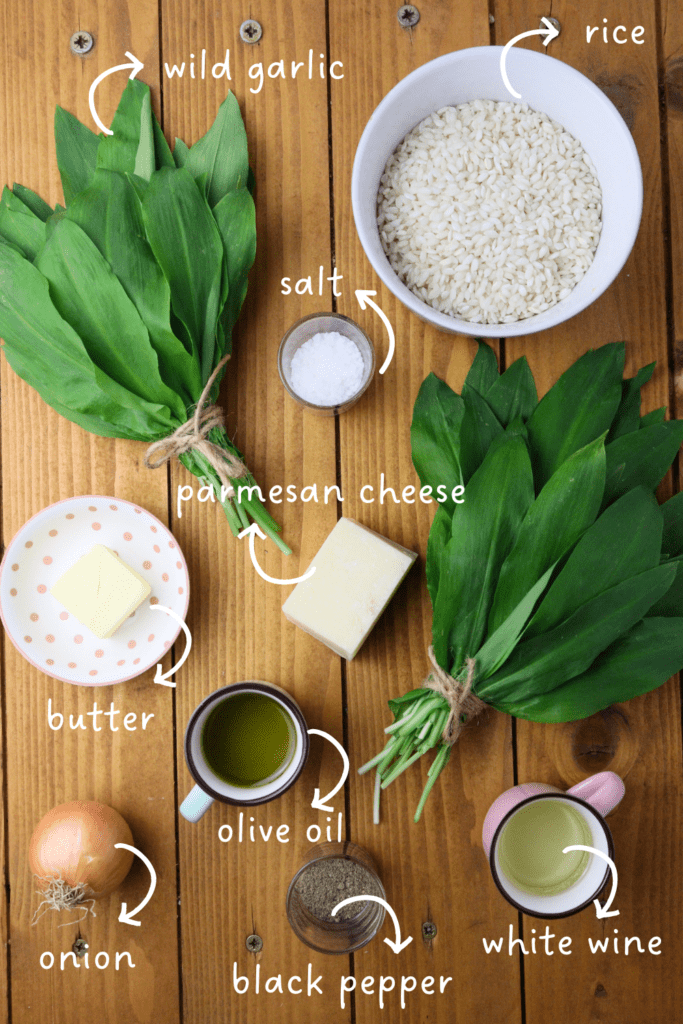
How to make wild garlic risotto
COOKING RICE
STEP 1: Peel and dice a medium-sized onion into pieces as small as possible. Heat olive oil in a pan and saute the onion for a few minutes until it turns nice yellow, tender and translucent.
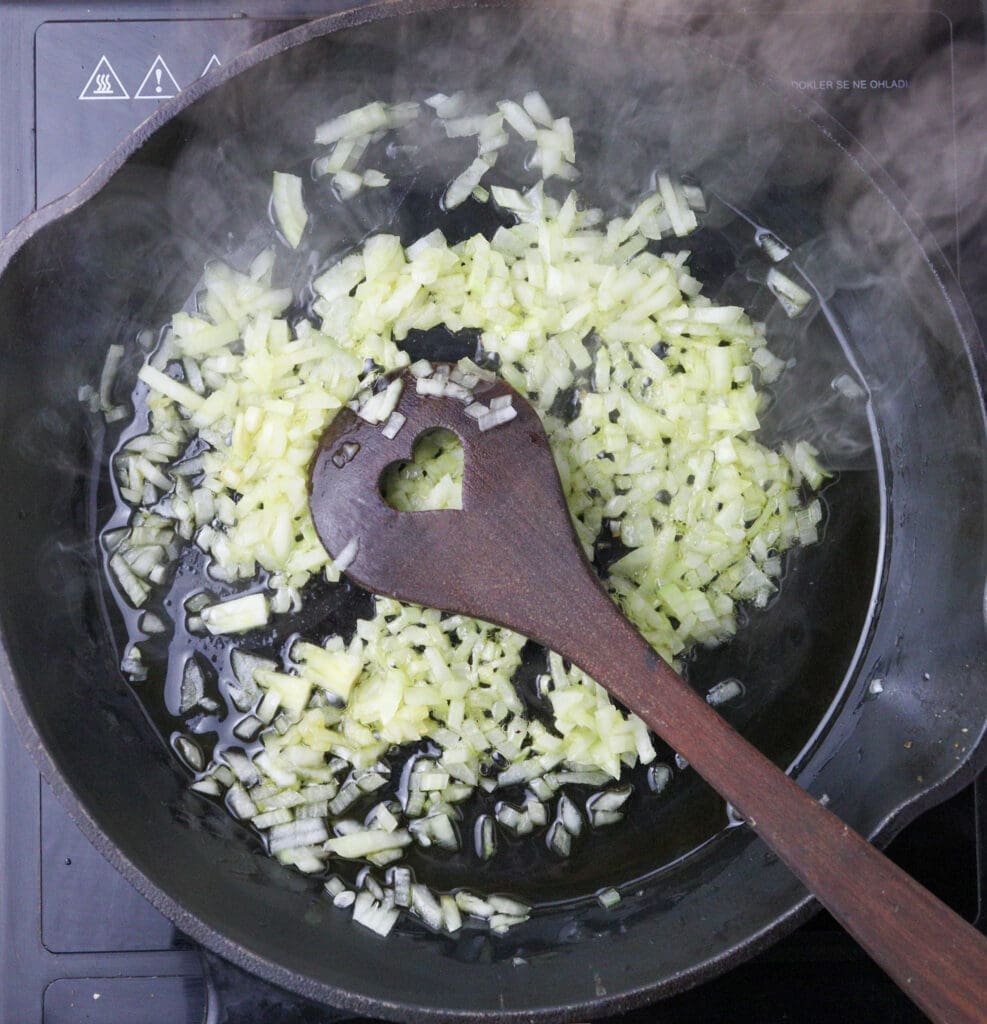
STEP 2: Add rice to the pan and quickly toast it for a minute. This helps slightly cook the rice grains’ outer layer, allowing them to absorb liquid and flavors better.
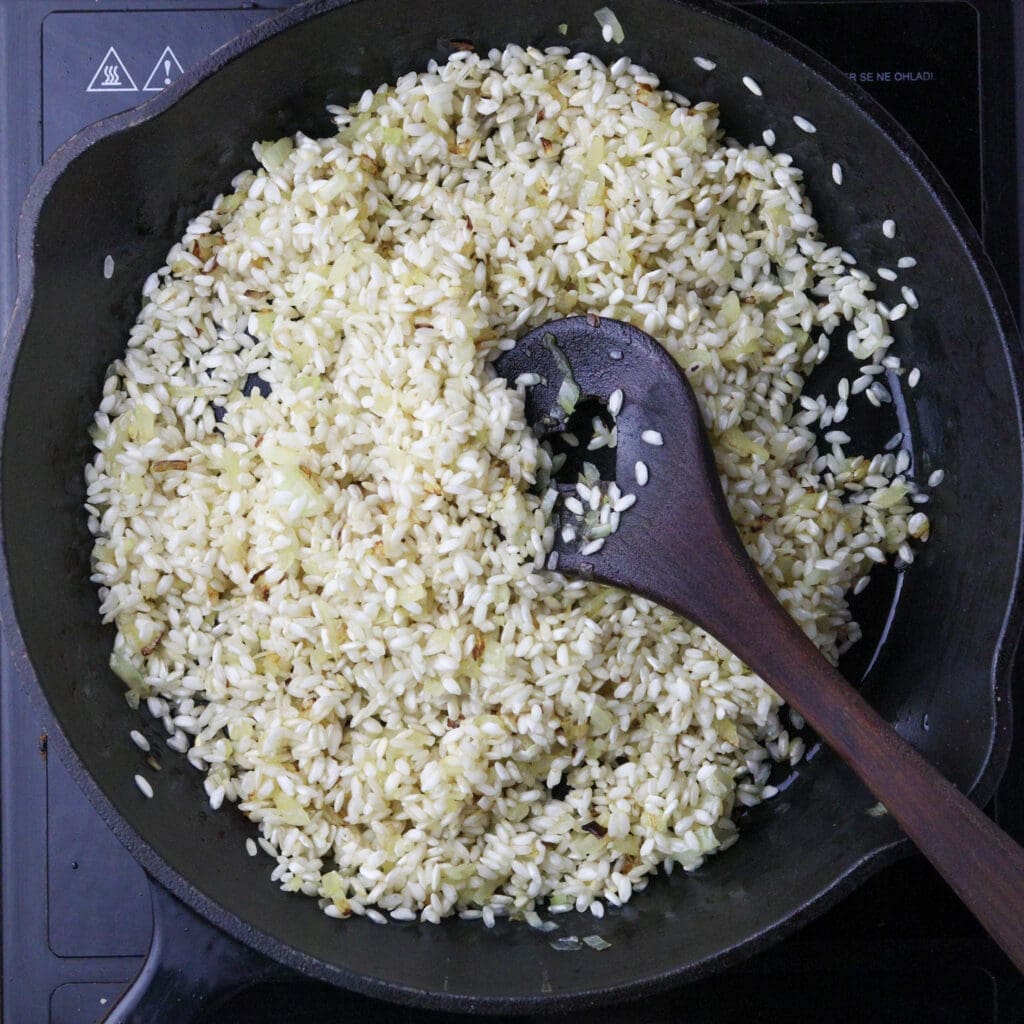
STEP 3: Add wine, warm water and salt to taste. When making risotto, warm water should be added gradually. When adding water, ensure the rice soaks it well before adding more. You can opt for broth instead of water, but only add enough liquid to cover the rice at a time.
Stir frequently. Frequent stirring ensures even cooking and prevents the rice from sticking to the bottom of the pot. Moreover, this will make your risotto creamier because it helps to release the starches from the Arborio rice.
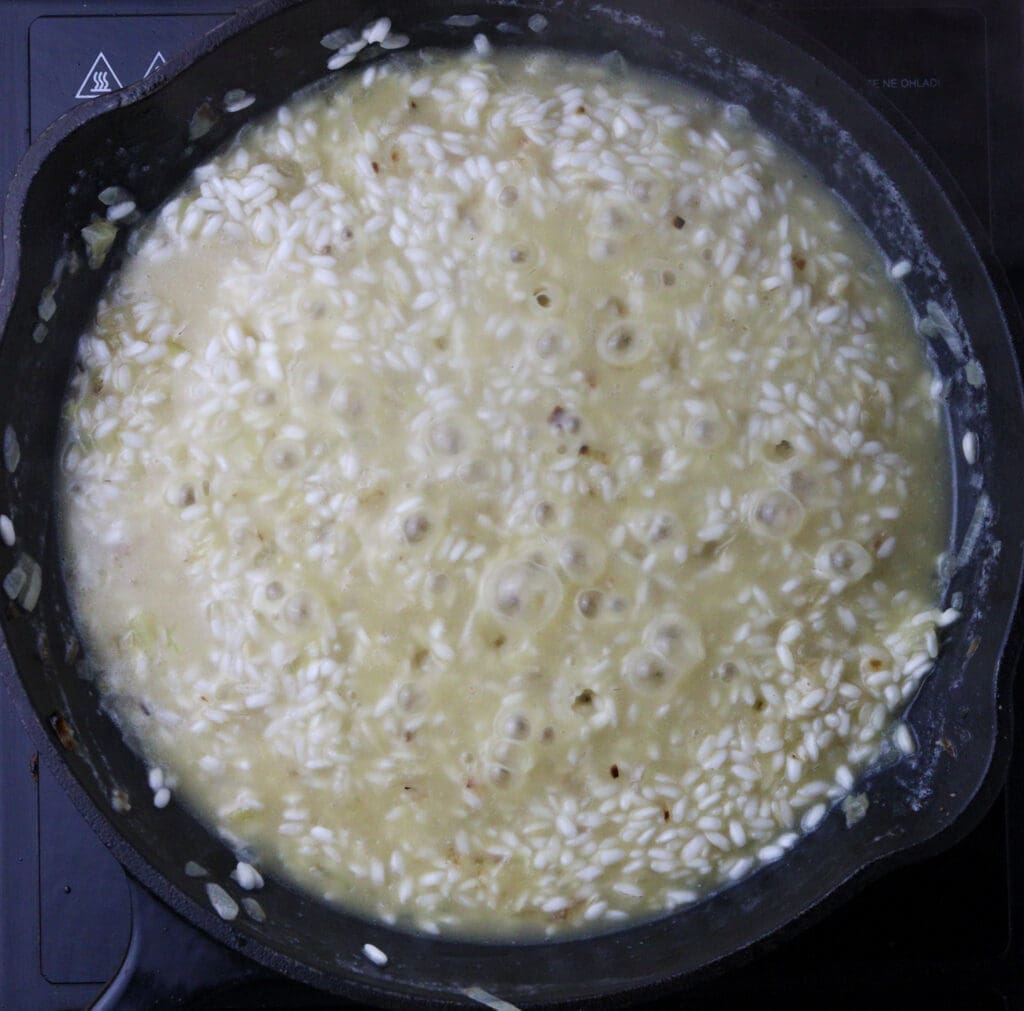
STEP 4: While the risotto is cooking, prepare and thoroughly rinse your wild garlic leaves under cold running water. If you were foraging wild garlic yourself, this is a chance to check again that no other plants are among your greens.
ADDING WILD GARLIC
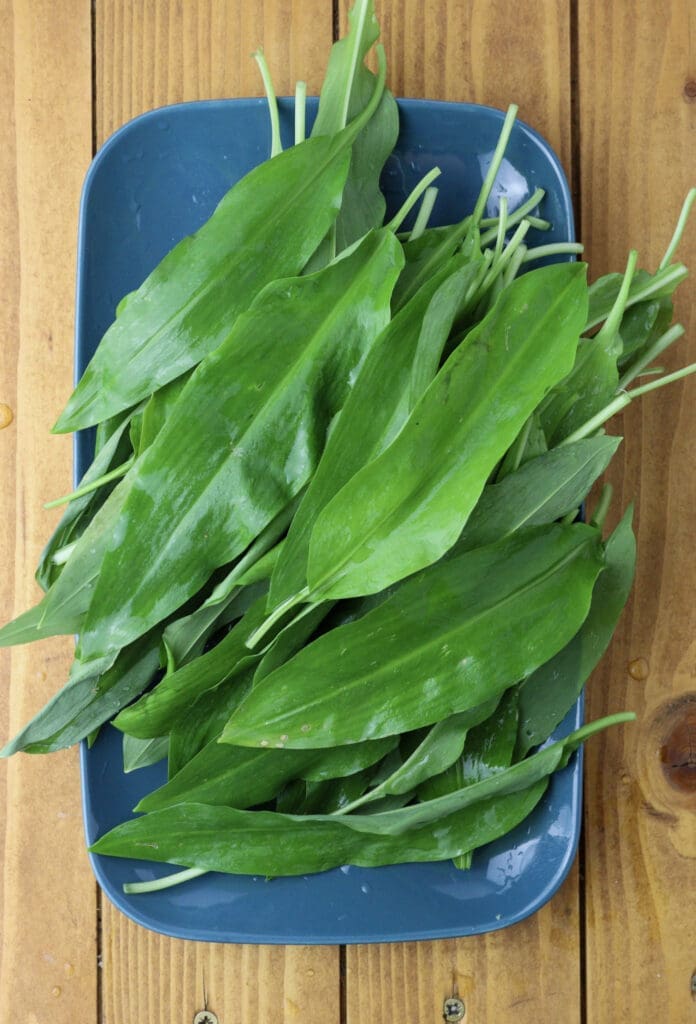
STEP 5: Chop the leaves into smaller pieces or blend them, adding a small amount of olive oil to the blender. The taste of risotto with blended wild garlic will be more intense and bright green in color.
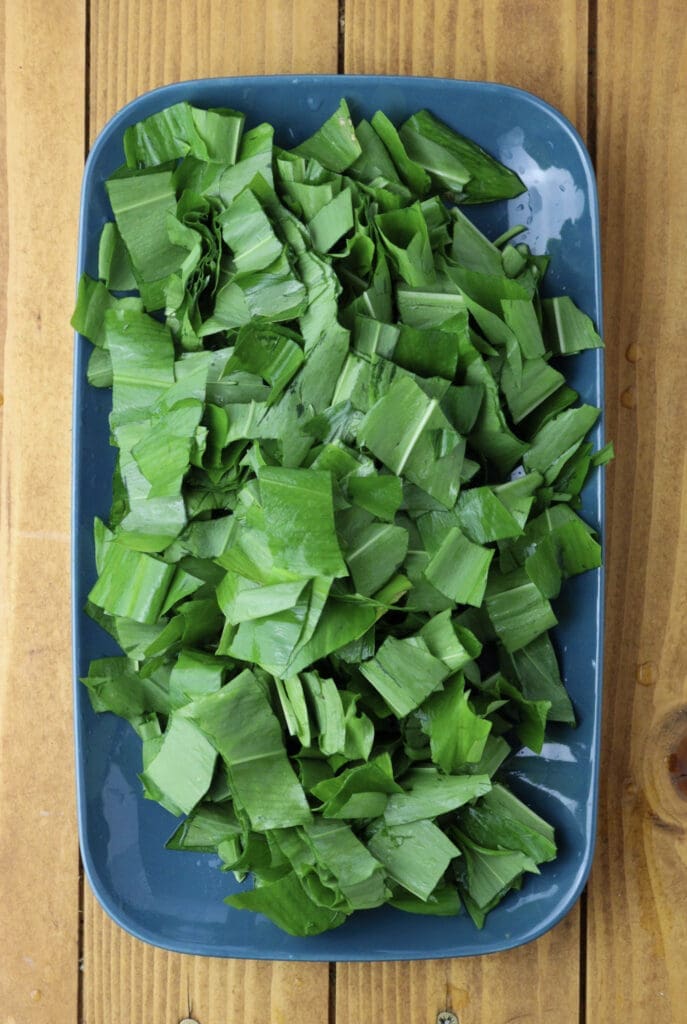
STEP 6: When the risotto is almost done (which takes about 18-20 minutes), add the chopped garlic leaves and stir until they are evenly incorporated into the dish.
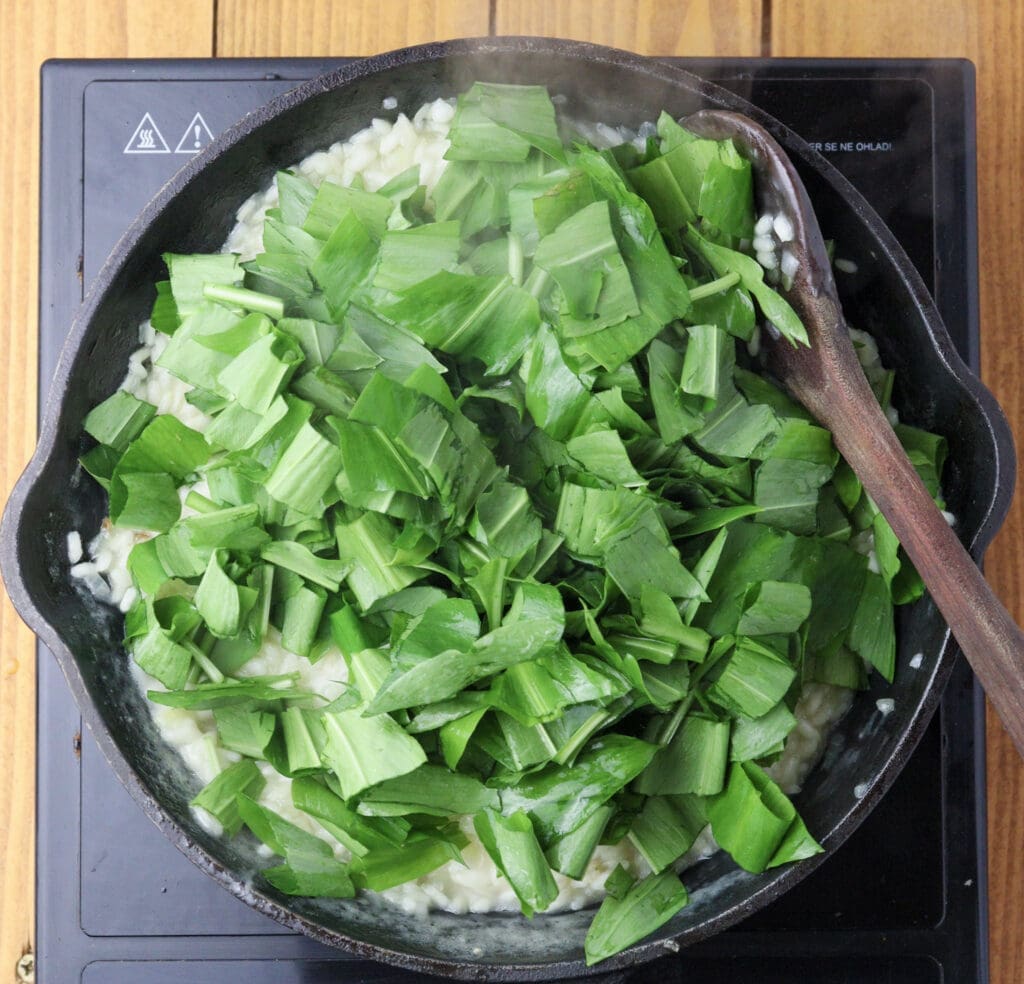
STEP 7: When cooked (the rice is tender but still al dente) and most of the liquid has been absorbed, it’s time to add the butter. The butter should be cold to help create a smooth emulsion. Stir the risotto vigorously to incorporate it into the whole dish.

STEP 9: Lastly, add grated fresh parmesan cheese, mixing until the cheese melts and blends smoothly into the risotto. Adding parmesan cheese to risotto really amps up the flavor, giving it that rich kick that makes it delicious beyond words. Plus, it makes the risotto extra creamy.
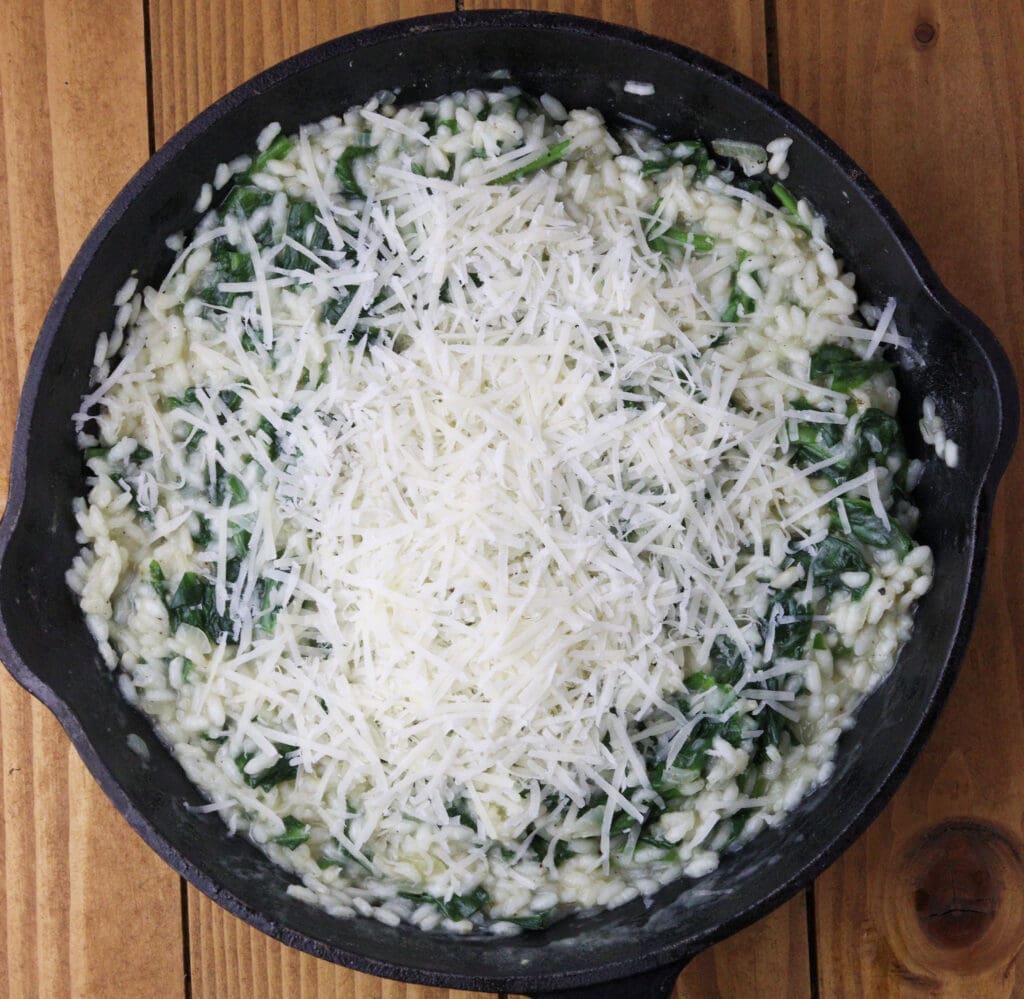
STEP 10: Garnish with wild garlic flowers and serve immediately while still fresh and hot.
Wild garlic risotto pairs perfectly with shrimp, grilled chicken breasts, roasted vegetables and a good salad. You might want to finish the meal with a slice of a delicious no-bake dandelion cake. And a glass of good white wine is also not a bad idea. Enjoy!

Tips for a perfect wild garlic risotto
- Use fresh wild garlic. It tastes best when cooked freshly foraged. If you can’t cook it immediately, keep it in the refrigerator.
- Use quality rice. Good-quality Arborio rice, with its high starch content, gives risotto that creamy texture we all love.
- Use warm water or broth. Adding cold liquid can shock the rice and slow down the cooking process. Keep your broth or water simmering on a nearby burner so it’s always ready to go.
- Cook it slowly. Patience is key when making risotto. Cook it over medium heat to allow the rice to release its starches gradually.
- Stir often. This is how the rice’s starches are actually released, creating a smooth, creamy, delicious risotto.
- Don’t overcook the rice. Keep tasting as you go to make sure you hit that perfect balance. Creamy, but still al dente is the way.
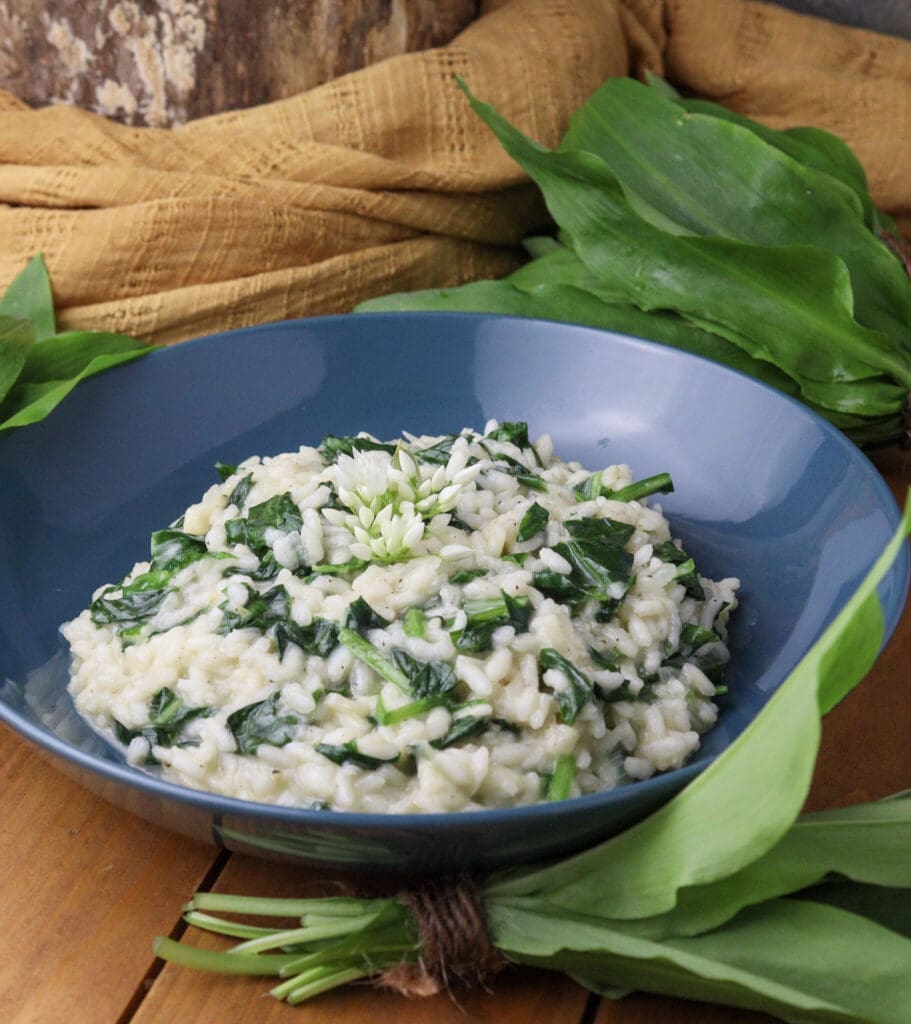
How to store it
Before storing, make sure to cool your wild garlic risotto to room temperature. Spread it out on a baking sheet if you’re in a hurry – this helps it cool faster and prevents it from getting mushy.
It will keep well in the refrigerator for up to three days, ensuring that it’s stored in an airtight container.
If you’ve made a big batch and want to save some for later, you can freeze it. Transfer the risotto into airtight containers or freezer bags and label them with a date. Frozen risotto can last up to two months, but the sooner you use it, the better.
When reheating it, add a bit of broth or water to a saucepan and heat the risotto over medium-low, stirring until it’s warmed through.
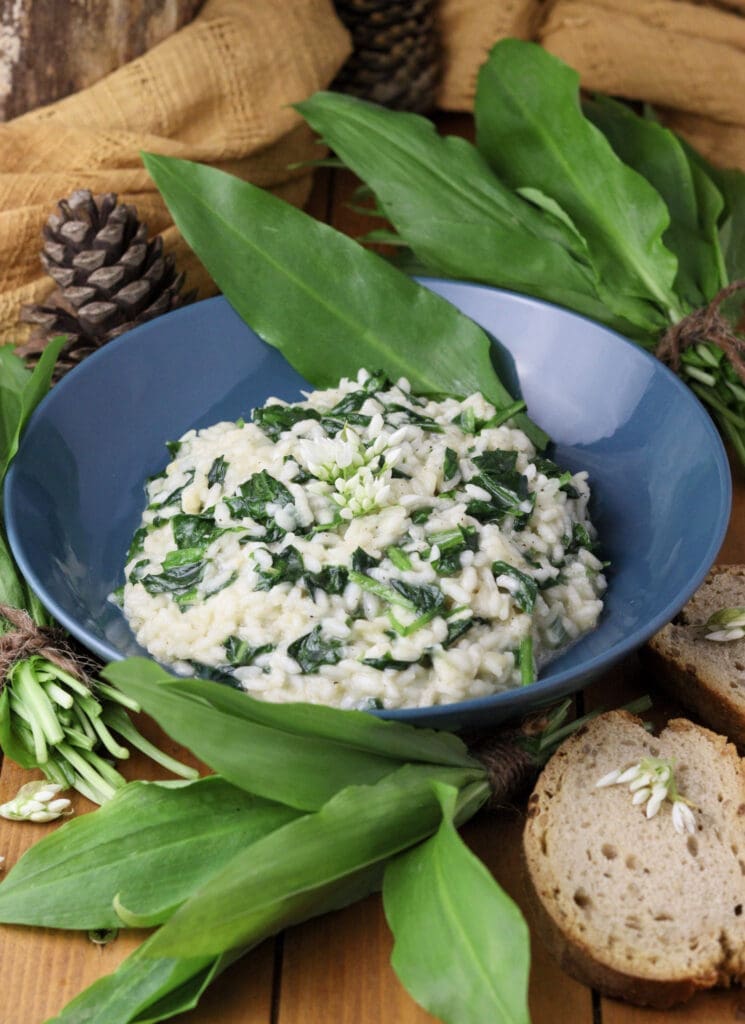
Wild garlic risotto FAQs
Wild garlic is a close cousin of chives. If wild garlic isn’t available, chives make an excellent alternative.
You can substitute the butter with more olive oil or vegan butter, and use nutritional yeast instead of parmesan cheese for a delicious, creamy vegan wild garlic risotto.
Asparagus and peas are fantastic additions to wild garlic risotto, adding a fresh, springtime flavor and vibrant color. Mushrooms also work well, bringing an earthy taste that beautifully pairs with the creaminess.
Absolutely not! You can skip the white wine if you prefer, your risotto will still taste good without it.
Wild garlic grows in the eastern half of the US and on the west coast. It is often called ramps or wild onion. In Texas alone, there are 14 species of wild onions. If you don’t live in an area where wild garlic would grow in the wild, you might want to plant it in a shady area of your garden.
Yes, you can freeze it. Blanch it for two minutes in boiling water, cool it to room temperature, put it in an airtight container or freezer bag, and store it in the freezer for up to six months.
Absolutely safe to consume wild garlic once properly identified. Be responsible while foraging, steer clear of look-alikes like Lily of the Valley, and ensure thorough washing before use.
More risotto recipes
Bulgur risotto with chanterelle mushrooms
Foraged food you might like
Green gnocchi with wild spinach
Pesto with pistachios and Grana Padano
Wild Garlic Risotto
EQUIPMENT
- 1 saucepan
INGREDIENTS
- 1,5 cups Arborio rice (320 g)
- 1 bunch fresh wild garlic leaves
- ½ cup white wine 120 ml
- ½ tbsp olive oil (15 ml)
- 1 cup parmesan cheese (120 g)
- 2 tbsp butter (28 g)
- salt
- black pepper
- 4 cups broth (1 liter, optional)
INSTRUCTIONS
- Dice an onion into pieces as small as possible. In a large pan, heat up olive oil, add diced onion and cook for 5 to 7 minutes or until golden and tender.
- Add rice to the pan and quickly toast it for a minute.
- Pour in wine and water (or broth), just enough to cover up the rice. Add salt to taste. Cook on low-medium heat.
- Stir frequently and keep adding the liquid. Never add more than needed for the rice to soak it up. Continue repeating the process.
- Thoroughly rinse your wild garlic leaves under running water and chop them into smaller pieces. You can use a blender for a more intensive garlicky flavor.
- After about 18-20 minutes, when the risotto is almost cooked, add wild garlic leaves and stir to evenly incorporate the into the risotto.
- When done, add cold butter and stir intensively until the risotto gets a rich, creamy texture.
- Lastly, add grated fresh parmesan cheese, mixing it into the dish until the cheese melts and blends smoothly into the risotto
- Serve with a glass of good wine and enjoy 🙂
Video
NOTES
NUTRITION
Proudly announcing our risotto was featured at Angie’s Fiesta Friday, Suzanne’s Pieced Pastimes and Kristin’s The fifth sparrow no more.

If you liked the recipe, please rate it in the comments below.
Show your love by sharing ❤️

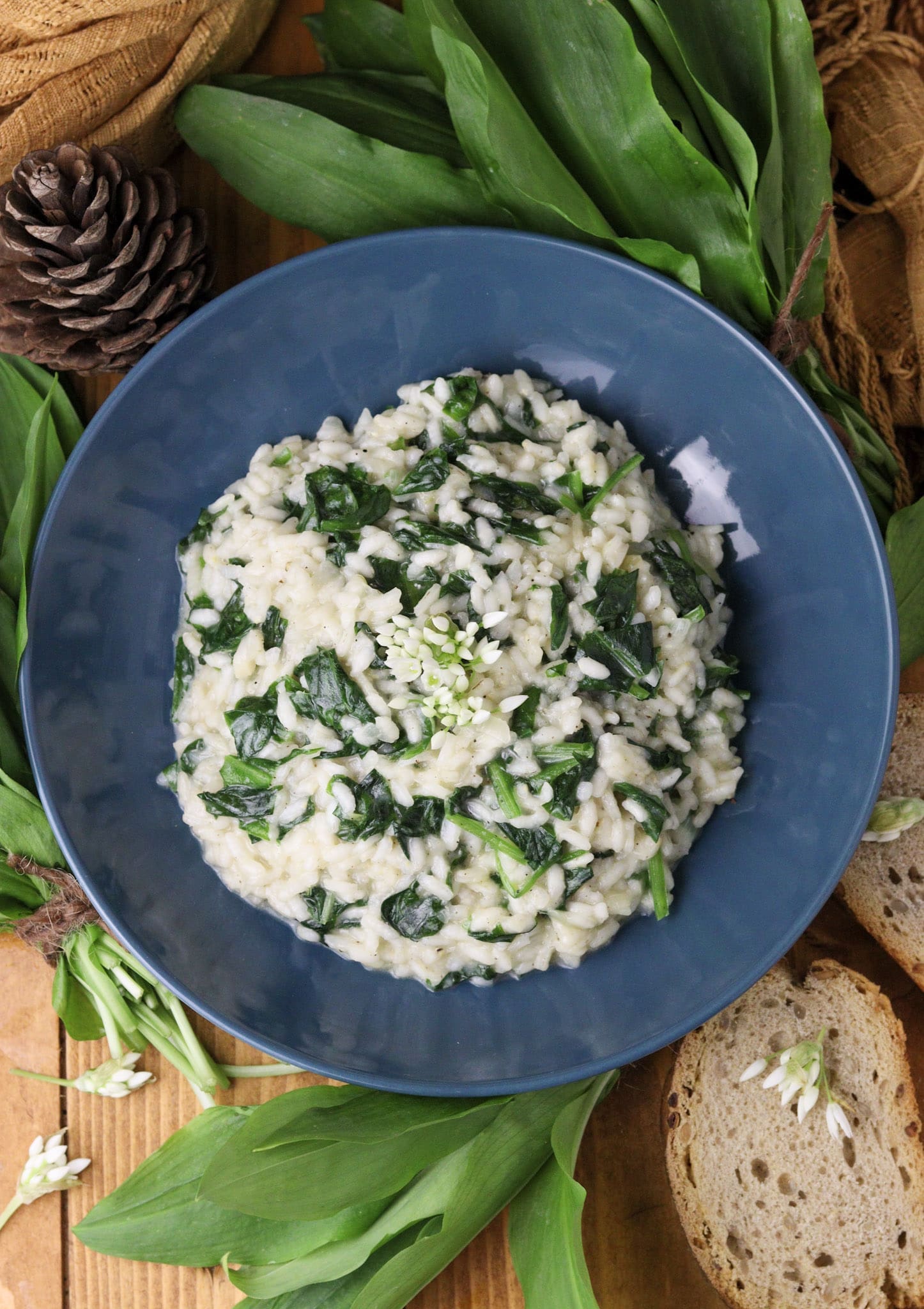


Amazing, love risotto and garlic, so this is perfect to try.
I visited you via Pam’s Party & Practical Tips: It’s Time to Dare to Share! My entries this week are numbered #25+26.
Please join and share your posts with us https://esmesalon.com/tag/seniorsalonpitstop/
Thanks Esme, more wild garlic recipes are coming. I’ll be happy to share our risotto, see you soon!
Oh, my. Do you hire out to cook for people?! hahaha. As Esme can tell you, I am not the cook in my house! This sounds delicious. Thank you for sharing!
Thank you so much for your kind words! I’m flattered that you like the recipe. No, I don’t hire out to cook, but I’m thrilled that you find the recipe enticing! I hope you give it a try, and who knows, maybe you’ll surprise Esme with your cooking skills! If you have any questions or need any tips, feel free to reach out. Happy cooking!
Thanks for the delicious and unique recipe.
Thanks Bernadette! I’m happy that you enjoyed our recipe. It’s such a flavourful and easy to make dish, and the taste of wild garlic is wonderful.
Wow, that looks so good! And to think I had never heard of wild garlic. Who knew?
Thank you! Wild garlic is indeed a fascinating and flavorful plant. It’s actually quite similar to ramps or ramson or wild leek, sometimes it’s called bears garlic. All of these plants belong to the Allium family, the same family that includes onions, garlic, and leeks.
Sounds amazing!
Thank you Susan!
I’ve never made risotto – I’ve been afraid to try. Your instructions are really clear and it doesn’t seem so complicated. I think I’m going to try! Thanks for sharing at the What’s for Dinner party.
Thank you, Helen! I’m glad to hear that the instructions are clear and approachable for you. Risotto can seem intimidating, but once you get the hang of it, it’s actually quite simple! I hope you’ll enjoy making it, and be sure to let me know how it turns out for you. And thank you for hosting the What’s for Dinner party — it’s always a great place with many beautiful creations. I definitely enjoy it!
This looks and sounds amazing! Great recipe, and I enjoyed the video tutorial as well. Thank you for sharing at The Crazy Little Lovebirds link party #41. 😊
Thanks Steph, I’m really happy that you liked it.
Great post. Thanks for sharing. I will definitely try this one.
Lynne
Thanks Lynne, I hope you’ll love it!
This looks so delicious! Thank you for sharing with us on the Homestead Blog Hop. I hope we see more this Wednesday.
Thanks Kelly, see you soon!